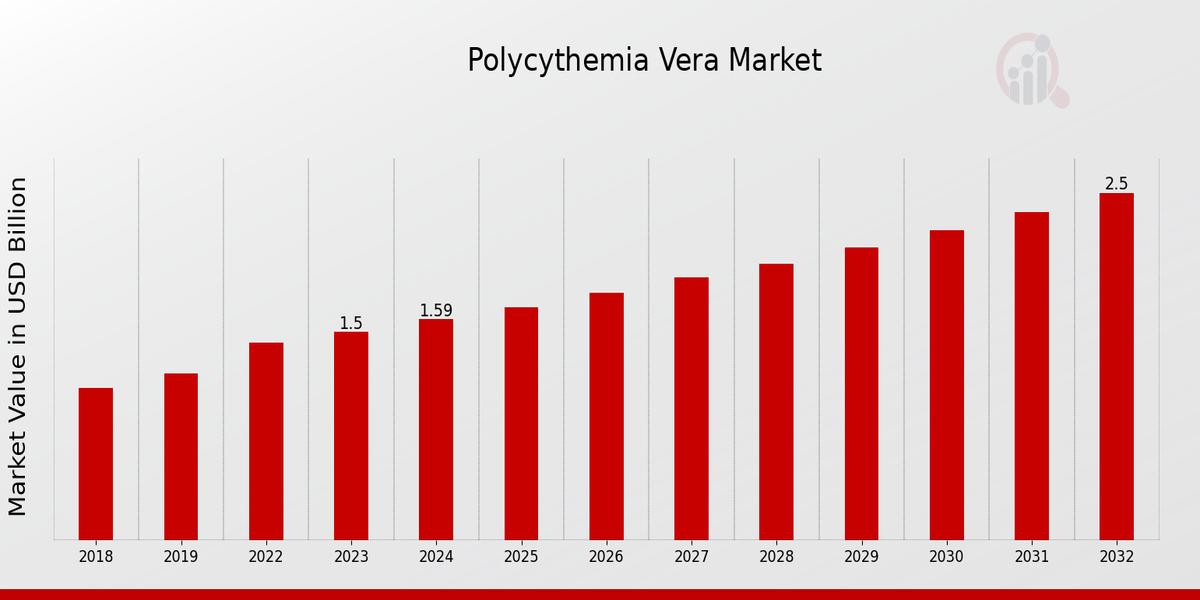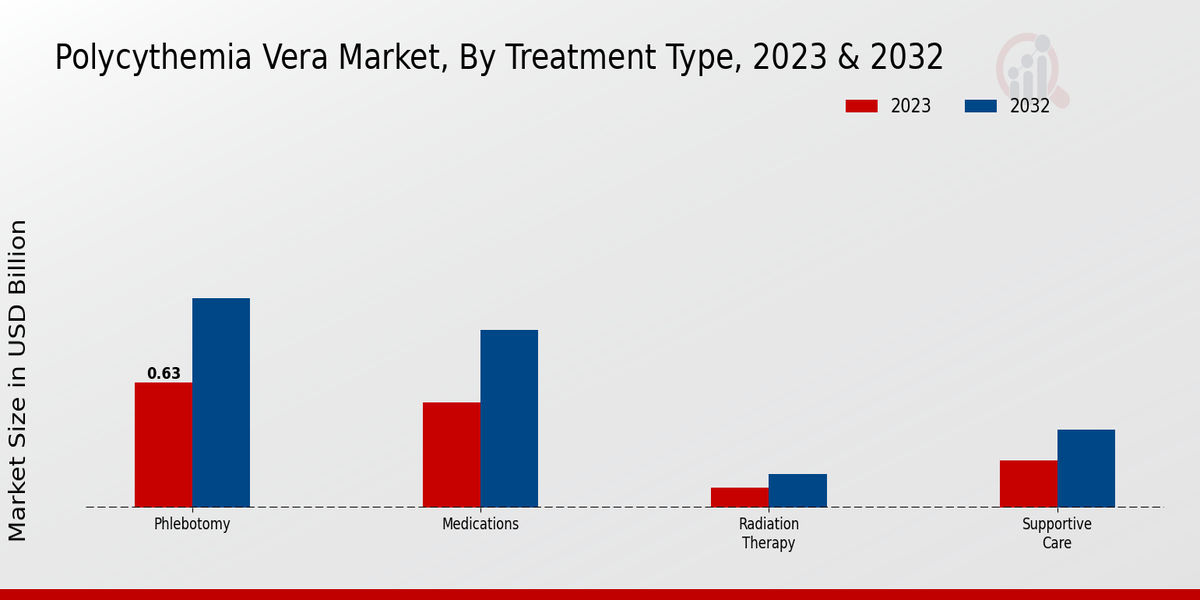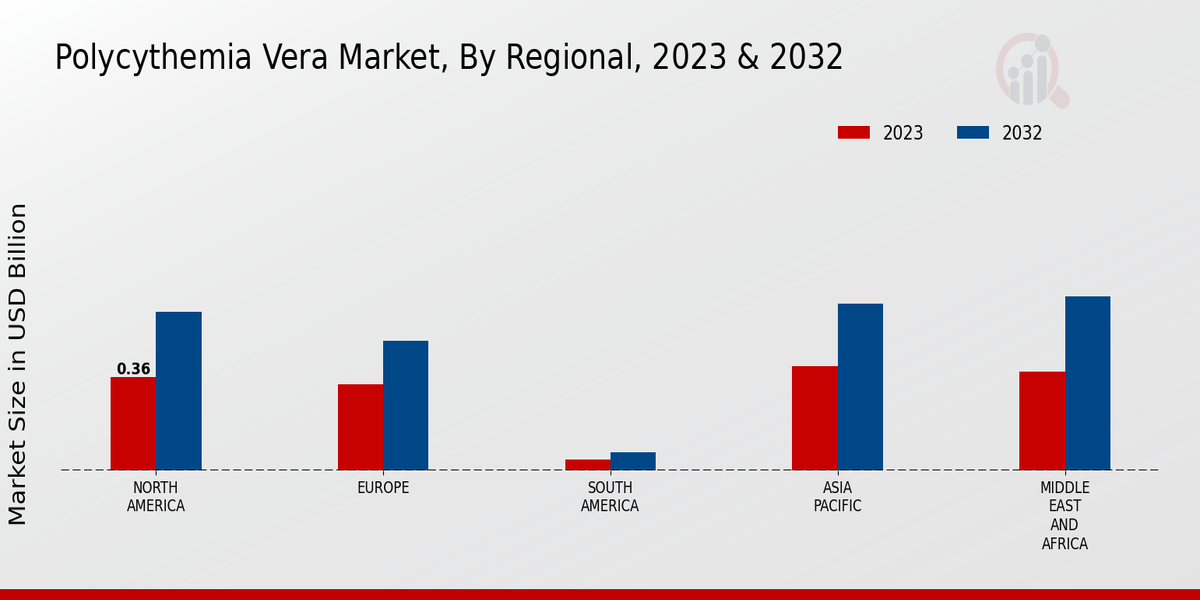Polycythemia Vera Market Overview
As per MRFR analysis, the Polycythemia Vera Market Size was estimated at 1.2 (USD Billion) in 2023. The Polycythemia Vera Market Industry is expected to grow from 1.28 (USD Billion) in 2024 to 2.03 (USD Billion) by 2032. The Market CAGR (growth rate) is expected to be around 5.24% during the forecast period (2024 - 2032).
Key Polycythemia Vera Market Trends Highlighted
The Polycythemia Vera market is characterized by ongoing developments in treatment approaches and therapeutic options. Key market drivers include the rising prevalence of the disease, advancements in targeted therapies, and increasing awareness among healthcare professionals. Recent trends indicate a growing focus on personalized medicine and the development of novel therapies tailored to individual patient profiles. Additionally, there is an increasing emphasis on patient-reported outcomes and improvements in quality of life. Opportunities for exploration and capture lie in the further development of targeted therapies, the integration of genomic profiling, and the advancement of supportive care measures to manage complications associated with polycythemia vera.

Source: Primary Research, Secondary Research, MRFR Database and Analyst Review
Polycythemia Vera Market Drivers
Increasing Prevalence of Polycythemia Vera
Polycythemia vera is a rare blood cancer that causes the body to produce too many red blood cells. The exact cause of polycythemia vera is unknown, but it is thought to be caused by a combination of genetic and environmental factors. The prevalence of polycythemia vera is increasing worldwide, and it is estimated that there will be over 200,000 new cases diagnosed each year by 2030. The increasing prevalence of polycythemia vera is a major driver of growth in the Polycythemia Vera Market Industry.
Rising Demand for Novel Therapies
The treatment landscape for polycythemia vera is evolving rapidly, with the development of novel therapies that are more effective and have fewer side effects. These novel therapies include JAK inhibitors, which are targeted therapies that block the JAK-STAT signaling pathway, and ropeginterferon alfa-2b, a long-acting form of interferon alfa. The rising demand for novel therapies is a major driver of growth in the Polycythemia Vera Market Industry.
Growing Awareness of Polycythemia Vera
Another factor that drives the growth in the Polycythemia Vera Market Industry is the growing awareness of the disease. This is driven by several factors, such as a higher incidence of the disease, more effective new treatments, and also by the activities of patient advocacy groups. Because of these factors, more and more patients are diagnosed and treated, which drives the demand in the Polycythemia Vera Market Industry.
Polycythemia Vera Market Segment Insights
Polycythemia Vera Market Treatment Type Insights
The Polycythemia Vera Market is segmented by Treatment Type into Phlebotomy, Medications, Radiation Therapy, and Supportive Care. In 2023, the Medications segment accounted for the largest share of the overall market revenue, primarily due to the widespread use of hydroxyurea, a medication that reduces the production of red blood cells. Phlebotomy, a procedure involving the removal of excess red blood cells from the body, is also commonly used as a first-line treatment for Polycythemia Vera. Phlebotomy helps reduce blood viscosity and improve blood flow, alleviating symptoms such as headaches, dizziness, and fatigue.The Polycythemia Vera Market revenue for Phlebotomy is expected to grow at a steady pace over the forecast period, driven by the increasing prevalence of the condition and the need for regular phlebotomy sessions. Radiation Therapy, which involves the use of high-energy radiation to target and destroy overactive bone marrow, is another treatment option for Polycythemia Vera. However, Radiation Therapy is typically reserved for patients who do not respond well to other treatments.
The Polycythemia Vera Market revenue for Radiation Therapy is expected to remain relatively stable over the forecast period.Supportive Care measures, including lifestyle modifications, regular monitoring, and symptom management, play a crucial role in the management of Polycythemia Vera. Supportive Care can help improve the quality of life for patients and reduce the risk of complications. The Polycythemia Vera Market revenue for Supportive Care is expected to increase steadily over the forecast period, driven by the growing awareness of the importance of comprehensive patient care. Overall, the segmentation of the Polycythemia Vera Market by Treatment Type provides insights into the diverse treatment options available and their respective market dynamics.This data is essential for stakeholders in the healthcare industry, including pharmaceutical companies, medical device manufacturers, and healthcare providers, to make informed decisions and develop effective strategies for addressing the needs of patients with Polycythemia Vera.
Figure2: Polycythemia Vera Market, By Treatment Type, 2023 & 2032 (USD billion)

Source: Primary Research, Secondary Research, MRFR Database and Analyst Review
Polycythemia Vera Market Medication Class Insights
The Polycythemia Vera Market Medication Class segment comprises three classes of drugs, namely Hydroxyurea, Ruxolitinib, and Interferon. Hydroxyurea is the most commonly used medication for Polycythemia Vera and is popular due to its effectiveness in lowering the number of blood cells and managing symptoms. Ruxolitinib is a relatively new medication that has demonstrated good results in managing splenomegaly and constitutional symptoms, mainly due to the reduction of inflammation. Meanwhile, Interferon is another option for Polycythemia Vera, but its use is limited by the presence of other more effective and well-tolerance therapies.The Polycythemia Vera Market data show that in 2023, Hydroxyurea was leading in the Medication Class segment with respect to revenue. This was followed by Ruxolitinib and, finally, Interferon. Overall, it can be assumed that with time the market of medications used for Polycythemia Vera will be gradually growing due to increasing prevalence and development of new better therapeutics.
Polycythemia Vera Market Prognosis Insights
The Polycythemia Vera market is segmented by prognosis into low-risk, intermediate-risk, and high-risk. The intermediate-risk segment is expected to grow at a CAGR of 6.2%, while the high-risk segment is expected to grow at a CAGR of 6.5%. The growth of the low-risk segment is attributed to the increasing prevalence of the disease in the elderly population, as well as the availability of effective treatments. The growth of the intermediate-risk and high-risk segments is attributed to the increasing incidence of the disease in younger populations, as well as the development of new and innovative treatments.
Polycythemia Vera Market Mutation Status Insights
The Polycythemia Vera Market is segmented by Mutation Status into JAK2 V617F Mutation, CALR Mutation, and MPL Mutation. Among these, the JAK2 V617F Mutation segment held the largest market share in 2023 and is expected to continue its dominance throughout the forecast period. The high prevalence of the JAK2 V617F mutation in Polycythemia Vera patients is a key factor driving the growth of this segment. The CALR Mutation segment is also expected to witness significant growth during the forecast period due to the increasing awareness and diagnosis of CALR-mutated Polycythemia Vera.The MPL Mutation segment is expected to grow at a moderate pace over the forecast period. The Polycythemia Vera Market revenue is expected to reach $1.8 billion by 2024, exhibiting a CAGR of 6.2% during the forecast period.
Polycythemia Vera Market Indication Insights
The Polycythemia Vera Market segmentation by indication includes primary polycythemia vera and secondary polycythemia vera. Primary polycythemia vera, also known as Polycythemia vera (PV), is a rare blood cancer that causes the body to make too many red blood cells. Secondary polycythemia vera is a condition in which the body makes too many red blood cells in response to another underlying medical condition, such as chronic lung disease or kidney disease.
In 2023, the primary polycythemia vera segment held a larger share of the Polycythemia Vera Market revenue, and it is expected to continue to dominate the market throughout the forecast period. The growth of this segment can be attributed to the increasing prevalence of the disease and the rising demand for effective treatments. The secondary polycythemia vera segment is also expected to witness significant growth during the forecast period, owing to the increasing awareness of the condition and the availability of new treatment options.
Polycythemia Vera Market Regional Insights
The regional segmentation of the Polycythemia Vera Market offers insights into the market's geographic distribution and growth dynamics. North America is expected to dominate the market in 2024, accounting for a significant share of the Polycythemia Vera Market revenue due to the presence of well-established healthcare infrastructure, high prevalence of Polycythemia Vera, and favorable reimbursement policies. Europe is anticipated to hold the second-largest market share, driven by the increasing geriatric population and rising awareness of Polycythemia Vera.The APAC region is projected to exhibit the fastest growth rate during the forecast period, owing to the increasing healthcare expenditure, growing population, and rising prevalence of Polycythemia Vera. South America and MEA are expected to contribute a smaller share to the Polycythemia Vera Market, but they are expected to witness steady growth due to the improving healthcare infrastructure and increasing access to advanced treatment options.
Figure2: Polycythemia Vera Market, By Regional, 2023 & 2032 (USD billion)

Source: Primary Research, Secondary Research, MRFR Database and Analyst Review
Polycythemia Vera Market Key Players And Competitive Insights
Major players in the Polycythemia Vera Market industry are continuously investing in research and development to introduce innovative products and expand their market presence. The market is characterized by a high level of competition, with a number of leading Polycythemia Vera Market players holding a significant market share. Some of the prominent players in the Polycythemia Vera Market development include Novartis, Incyte, and Bristol-Myers Squibb. The Polycythemia Vera Market Competitive Landscape is expected to remain highly competitive in the coming years as new players enter the market and existing players expand their product portfolios.Incyte is a leading Polycythemia Vera Market player with a strong portfolio of JAK inhibitors.
The company's Jakafi drug is approved for the treatment of polycythemia vera and other myeloproliferative neoplasms. Incyte has a strong research and development pipeline and is focused on developing new therapies for PV and other hematological conditions. The company's commitment to innovation is expected to help it maintain its position as a leader in the Polycythemia Vera Market.Bristol-Myers Squibb is another major player in the Polycythemia Vera Market. The company's Reblozyl drug is approved for the treatment of PV and other myelofibrosis conditions. Bristol-Myers Squibb has a strong commercial presence and is focused on expanding its market share in the PV market. The company's commitment to patient care and its strong financial position are expected to help it remain a major player in the Polycythemia Vera Market.
Key Companies in the Polycythemia Vera Market Include
Polycythemia Vera Market Industry Developments
The Polycythemia Vera market is anticipated to exhibit steady growth in the coming years, driven by rising prevalence of the disease and advancements in treatment options. In 2023, the market was valued at approximately USD 1.5 billion and is projected to reach USD 2.5 billion by 2032, expanding at a CAGR of around 5.81%.
Key factors contributing to market growth include increasing awareness about the disease, growing adoption of JAK inhibitors, and the introduction of novel therapies. Recent news developments in the market include the approval of new drugs such as ropeginterferon alfa-2b and pacritinib, which offer improved efficacy and tolerability over existing treatments. Additionally, the ongoing research and development activities in the field are expected to drive future market growth.
Polycythemia Vera Market Segmentation Insights
Polycythemia Vera Market Treatment Type Outlook
- Phlebotomy
- Medications
- Radiation Therapy
- Supportive Care
Polycythemia Vera Market Medication Class Outlook
- Hydroxyurea
- Ruxolitinib
- Interferon
Polycythemia Vera Market Prognosis Outlook
- Low-risk
- Intermediate-risk
- High-risk
Polycythemia Vera Market Mutation Status Outlook
- JAK2 V617F Mutation
- CALR Mutation
- MPL Mutation
Polycythemia Vera Market Indication Outlook
- Primary Polycythemia Vera
- Secondary Polycythemia Vera
Polycythemia Vera Market Regional Outlook
- North America
- Europe
- South America
- Asia Pacific
- Middle East and Africa
| Report Attribute/Metric |
Details |
| Market Size 2023 |
1.2 (USD Billion) |
| Market Size 2024 |
1.28 (USD Billion) |
| Market Size 2032 |
2.03 (USD Billion) |
| Compound Annual Growth Rate (CAGR) |
5.24% (2024 - 2032) |
| Report Coverage |
Revenue Forecast, Competitive Landscape, Growth Factors, and Trends |
| Base Year |
2023 |
| Market Forecast Period |
2024 - 2032 |
| Historical Data |
2019 - 2023 |
| Market Forecast Units |
USD Billion |
| Key Companies Profiled |
Pfizer, Takeda Pharmaceutical Company, Eli Lilly and Company, Astellas Pharma, Roche, Novartis, Celgene, Sanofi, AbbVie, Amgen, Merck Co., Incyte, Bristol Myers Squibb |
| Segments Covered |
Treatment Type, Medication Class, Prognosis, Mutation Status, Indication, Regional |
| Key Market Opportunities |
Targeted therapies for JAK2 Targeted therapies for MPL Improved patient monitoring Personalized treatment |
| Key Market Dynamics |
Increased disease prevalence Emerging targeted therapies Growing demand for minimally invasive procedures Advancement in genetic testing Rising healthcare expenditure |
| Countries Covered |
North America, Europe, APAC, South America, MEA |
Frequently Asked Questions (FAQ) :
The Polycythemia Vera Market is expected to reach USD 2.03billion by 2032, growing at a CAGR of 5.24% from 2024 to 2032.
North America is expected to dominate the Polycythemia Vera Market throughout the forecast period.
The increasing prevalence of Polycythemia Vera, the growing demand for targeted therapies, and the rising number of research and development activities are the key growth drivers of the Polycythemia Vera Market.
Some of the key competitors in the Polycythemia Vera Market include Incyte, Novartis, Bristol-Myers Squibb, and Pfizer.
The Polycythemia Vera Market is expected to grow at a CAGR of 5.81% from 2024 to 2032.
Polycythemia Vera is used to treat a variety of conditions, including myelofibrosis, essential thrombocythemia, and polycythemia vera.
Some of the key challenges faced by the Polycythemia Vera Market include the high cost of treatment, the lack of awareness about the disease, and the limited availability of effective therapies.
Some of the key trends in the Polycythemia Vera Market include the increasing use of targeted therapies, the growing adoption of personalized medicine, and the rising number of clinical trials.
The Polycythemia Vera Market is expected to reach USD 2.5 billion by 2032.
The base year considered for the Polycythemia Vera Market is 2023.

















